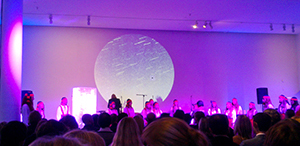Discours de Monsieur Juhan Parts, ministre des Affaires économiques
et de la Communication d’Estonie
 “Good evening, honoured presidents, designers, entrepreneurs, ladies and gentlemen!
“Good evening, honoured presidents, designers, entrepreneurs, ladies and gentlemen! This week Tallinn has been overtaken by innovative design fans – the European Innovation Festival IF is taking place within the programme of Tallinn, the European Capital of Culture 2011 and the VI Design Night.
The Innovation and Design Festival has a sizable programme, appropriate for a European Capital of Culture. The programme which consists of more than 45 events includes several conferences/workshops, exhibitions and other fascinating things. The heart of the Festival is in the Rotermann Quarter but all major museums and galleries all over the city are involved. Several events took place and are taking place in the urban space, also in galleries and design stores.
The festive Design Management Europe Awards gala today is a dignified finale for the Festival. Oscars of the design world, so to say, are awarded to European businesses which are successfully applying design to achieve a competitive edge. As an Estonian minister I am glad to see also 2 Estonian companies among the 15 finalists.
Through the centuries, Europe has been the continent which has influenced the whole world with its exemplary design and innovation. Year after year, design has increasingly become a driver of innovation and changes. Entrepreneurs who do not realise this are not sitting in this hall today, their products and services do not get attention or recognition, the image of their companies and brands is low.
The economic crisis clearly demonstrated that stronger and more capable businesses will survive, particularly those who are creative, innovative and unconventional in their activities. Those for whom design is not just a better sales argument for a product but those who apply strategic design throughout their production process.
 Design has three important roles for the state. Firstly, to be an engine for business development by adding to products and services the quality and functions that users would value. Secondly, to shape the public space, bearing in mind the cultural values and specific functional needs of the population. The third area for the application of design is the creation of a better social environment. In the development of the Estonian economy, design is a particular source of added value next to innovation.
Design has three important roles for the state. Firstly, to be an engine for business development by adding to products and services the quality and functions that users would value. Secondly, to shape the public space, bearing in mind the cultural values and specific functional needs of the population. The third area for the application of design is the creation of a better social environment. In the development of the Estonian economy, design is a particular source of added value next to innovation. I am glad that the first Estonian design school in Tallinn will celebrate its 100th anniversary soon. It is remarkable that this school – the Tallinn Industrial Art School with the current name Estonian Academy of Arts was created during World War I, in 1914, by Estonian manufacturers, and its director was Voldemar Päts, brother of the future Estonian President Konstantin Päts. According to him, also artists and designers were required for the reorganisation of the world besides bayonets. It is good to see that our Academy of Arts is the most recognised centre of design education in the Baltic States also today.
As I already mentioned, also the state has taken and is taking definite steps to favour the application of design both on the corporate and social level. Preparation of the National Action Plan for the Design Area for 2011–2013 is at its final stage; its objectives are to increase the proportion of businesses which apply design strategically in the Estonian economy and on the other hand to increase and develop the design sector so that it could provide increasingly better services both in Estonia and for export.
According to my evaluation, the key issue, so to say, for the competitiveness of Estonian businesses in the next few years, will be how to increase the application of design in the development of products and services. For this purpose also a programme called the Design Bulldozer Programme is the cornerstone of the current National Operational Strategy. The aim of the programme is to create with the assistance of designers and design managers product development concepts for participating businesses, which would be innovative in the market and offer actual valuable and meaningful solutions to users. Thus not only ideas for single products are sought here but a new approach and an area of subjects which could be used and developed further in the future.
To put it briefly, the aim is to lay the basis for design management in companies in its most strategic sense. To have increasingly more Estonian businesses also among the DME nominees and award-winners, which is one of the indicators of success.
Creativity, innovativeness and exemplary, I emphasise, strategic design are important both in the management of products of services and in state administration.
I wish success to all participants here today and will be waiting with you with excitement who will be the award-winners of Design Management Europe this year.”
 Le 23 septembre 2011, la remise des DME Awards par l'organisme
Le 23 septembre 2011, la remise des DME Awards par l'organisme 





